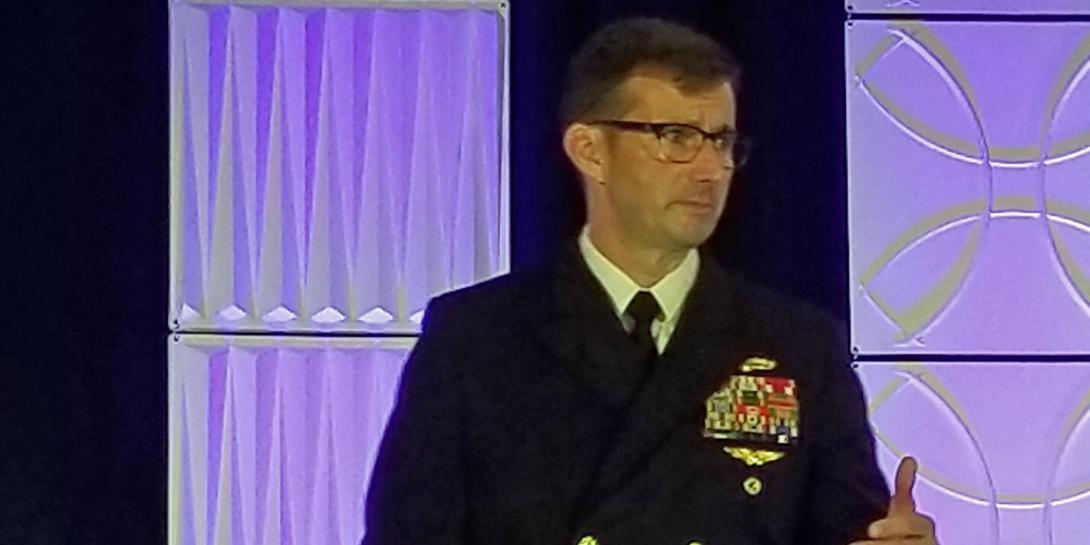SPAWAR Has Its Work Cut Out for It
To be the Navy the nation needs, the service must grow, leaders have decided. As part of the 2018 National Defense Authorization Act, Congress approved the Navy’s growth to 355 ships.
The Space and Naval Warfare Systems Command (SPAWAR) is responsible for fielding the gamut of the Navy’s information warfare. “It's intelligence systems. It's meteorological systems, it's electronic environment systems, if you will. It's cryptography systems, cybersecurity systems, data links, logistics systems, command and control systems, and interoperable systems with our partners,” said Rear Adm. Christian "Boris" Becker, USN, commander of SPAWAR. “If you think about the network with a capital N and all of the capabilities that go on that network, afloat and in the expeditionary environment, that’s what all of the SPAWAR programs look at.”
The commander shared his perspective at the Institute of Electrical and Electronics Engineers (IEEE) and AFCEA International’s MILCOM conference in Los Angeles on October 30.
RADM Christian Becker, USN, commander @SPAWARHQ: “We are in an area of strategic competition and we haven’t been in this situation in quite some time, and it is not a slam dunk.” pic.twitter.com/4xXrADsIdN
— Kimberly Underwood (@Kunderwood_SGNL) October 30, 2018
SPAWAR—pronounced spay-war, not Star Wars, the admiral joked—will need to field capabilities to all those new ships. However, the hard work of shipbuilding “can lead to strange decisions and strange outcomes,” Adm. Becker warned, citing the example of the 2017 delivery of the USS Gerald R. Ford, the world's most advanced aircraft carrier: SPAWAR delivered it with Windows XP.
“Not throughout, but we had an enclave of Windows XP on that ship, and why?” he said. “Because the owners of certain applications didn't have any drive or motivation to refactor to a new modern operating system. And as networks geeks, we've got to service the customer and bring that enclave of XP. I'm not sure the technical word for that, but I think it's wrong.”
SPAWAR is working to get past that kind of culture. “We have to get to the point where we can deliver a ship, we can deliver the infrastructure, we can deliver the protected size weight and power (SWAP) and cooling so that we can roll in a network that's fresh. That's a challenge and we're working on that challenge.”
Adm. Becker has set SPAWAR on a strategic mission through 2027. He acknowledges that as an information warfare, information technology (IT)-heavy organization, having a vision that goes out that far is risky, given the pace of change. But SPAWAR is setting its sights on its information warfare platform—its network.
The problem is that the network is everywhere, Adm. Becker noted. ““We use our network to conduct our business,” he said. “And our business is the business of preparing to compete and operate with our forces around the globe.”
Take the Super Hornet, a great airplane from Boeing, the admiral continued. “It goes fast, goes high, it looks cool, but it's just an airplane until you integrate radar on it, until you integrate countermeasures, until you integrate weapons stations, until you integrate weapons on those weapons stations and you integrate the pilot and aircraft interfaces,” he explained. “It's just an airplane. It becomes a weapons platform when you pull all that together.”
"It's just an airplane until you integrate radar, weapon systems and pilot interfaces. It becomes a weapons platform when you pull all that together." RADM Christian Becker, USN, commander @SPAWARHQ #MILCOM
— Kimberly Underwood (@Kunderwood_SGNL) October 30, 2018
For the Navy’s network to be that crucial information warfare platform, SPAWAR has “to be able to update that platform in the same way that we create new capabilities on other platforms, except we're going to go at the speed of IT,” the admiral stated.
That means integration, Adm. Becker continued. And being able to develop software at speed. SPAWAR needs to be able to offer agile software development with users, and enable that development in the cloud, conducting software integration and regression testing in the cloud. It also means being able to get an authorization to operate in a day, as opposed to 18 months, he said.
“Because if we treat the information network as a warfare platform, and I have accredited infrastructure as a service, accredited platform as a service, then I'm just working on the software,” the admiral said. “And that is speed of delivery to the network and getting capabilities to warfighters faster.”





Comments